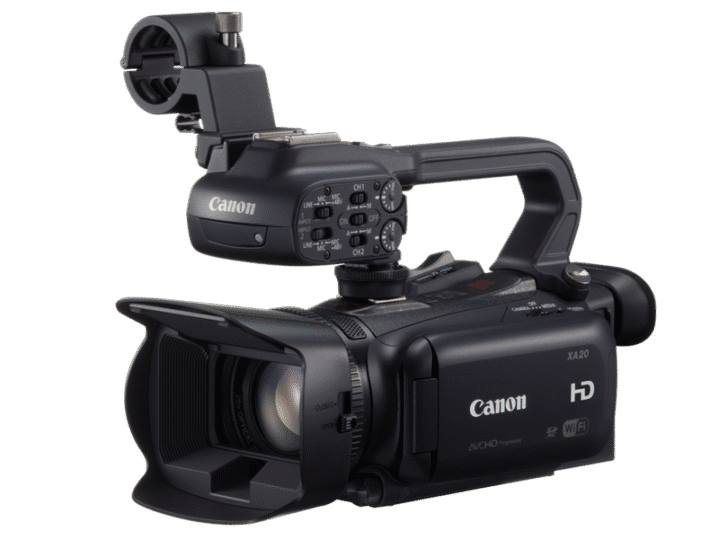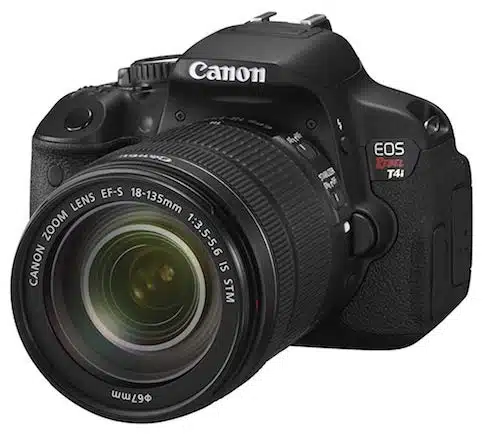by Tom Barrance | Updated October 2025
You don’t need an expensive camera to start filmmaking. The most important thing is to get started: use a camera you already own, use your phone, or buy a camera you can afford. If you’re on a tight budget, consider buying used: you can save a lot of money on a camera that’s a couple of years old. You could buy on eBay (check the seller ratings, and buy with a guarantee if possible). I also buy from MPB who offer a six month guarantee.
All the cameras on this page can shoot 1080p Full HD. This is good enough for most purposes, especially social media. If you don’t really need 4K you can save a lot of money by choosing a camera that doesn’t have it.
I’ve explained the differences between these kinds of camera, and their advantages and disadvantages here. Basically, camcorders are smaller and easier to use, but SLRs and mirrorless cameras offer more creative possibilities and a more ‘film-like’ look.
If you’ve got a good smartphone (e.g. iPhone 13 or later) I’d seriously consider kitting it out for video rather than buying an entry-level camcorder. You could get the free BlackMagic Camera app or Apple’s Final Cut Camera then add a microphone and a cage or stabiliser for well under $200/£200.
Avoid very cheap camcorders with unfamiliar brand names: most are poor quality and have fixed non-zoom lenses (they only have digital zooms).
Camcorder with microphone input: Canon HF-R700 and 800 (NTSC only)

The Canon HF-R800 (now discontinued) can record in a range of AVCHD and MP4 formats, including the 24fps that filmmakers like.
The zoom doesn’t go that wide – only 32.5mm equivalent – but there’s a filter ring so you could fit a wide angle adapter. It has a fairly large 3 inch touchscreen. Most importantly, it’s the cheapest good-quality camcorder you can buy with a microphone input socket. The older HF-R700 is almost identical.
Small wide-angle camcorder: Panasonic HC-V180
The big advantage of this little Panasonic is its genuine wide angle lens (28mm equivalent). So you can get in close for dramatic perspective and better audio.
It’s the first low-end Panasonic with optical image stabilisation. It’ll shoot in AVCHD and MP4, so it’ll be compatibile with most editing programs. If you use a Mac and want to save space, it also records in iMovie’s native iFrame mode. You can shoot time-lapse, and it can also record full 1080p HD with 50% slow motion.
But there’s no microphone input, headphone socket or viewfinder. The 2.7 inch touchscreen could be fiddly if you have large hands. Low-light performance from the 1/5.8” sensor – and battery life – isn’t great.
Prosumer camcorder

Older versions of Canon’s XA series camcorders like the XA20 or XA30 are fairly affordable used. They’re easy to use but have professional features like dials for audio levels and XLR inputs. I’ve used them on youth and schools filmmaking projects.
SLR or mirrorless
If you want an SLR or mirrorless camera in this price range, you’ll need to buy used.

SLRs have gone out of fashion for filmmaking, so you can save a lot by opting for them. Cameras like the Canon EOS T4i / Canon EOS 650D
have a large APS-C sensor, which is good for shallow depth of field, and it Canon’s excellent colour rendition. There are loads of lenses available in the Canon EF format, and you can fit other makers’ SLR lenses with adapters. It’s the first entry-level video Canon DSLR with a tilt-and-swivel touchscreen. It can shoot slow-motion, but only at 1280×720 rather than Full HD 1080.
If you can afford a bit more you could go for a pro model like the Canon EOS 70D or 80D.
You can install free Magic Lantern firmware (at your own risk) to add more video features.
Canon EOS-M

The original Canon EOS-M was the first mirrorless camera with a Canon APS-C sensor. At around $200/£150 or less used, it might be the most affordable camera you can buy for creative filmmaking. (Canon have now stopped making the EOS-M series.)
As with Canon SLRs, colours are great and you can get good shallow depth of field effects. There’s a limited range of small lenses devised specifically for the M series, but you can get adapters enabling you to mount any Canon SLR lens (or older manual focus lenses). It has a solid metal body, but it’s much smaller and lighter than an SLR. It has a fixed million-dot touchscreen.
It’s really small and neat and produces lovely images. Downsides: the touchscreen interface is slow to use, there’s no eye-level viewfinder, and battery life is poor so you’ll need spares.
It has the same range of video options as the T4i, and you can install Magic Lantern firmware for extra video features.
If you can afford a bit more it’s worth seeking out newer EOS models such as the M3 (review). It has a tilting screen, better controls, and the option to add an electronic viewfinder.
DJI Osmo Pocket

The original version of DJI’s tiny stabilised camera is a neat alternative to a camcorder, and it’s very cheap used. It has a 4K camera with a 28mm equivalent lens, and can record 1080p slow motion. I’d buy the wireless module and extension rod as well – it makes the camera much more useful. You could also spend more and get the Pocket 2. More about the Osmo Pocket.
What else you’ll need
Here’s my basic filmmaking kit list.



